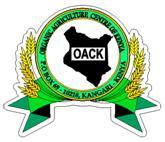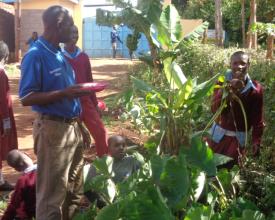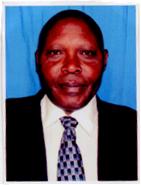
L'agro-biodiversité au service de la sécurité alimentaire : le cas de l'école de Joy town

SCOPE Kenya promeut les pratiques de permaculture pour aider les communautés scolaires à réaménager leur cour d'école et à établir un paysage terrestre productif et durable, avec une forêt vivrière et un microclimat frais, pour améliorer l'apprentissage, l'abondance et la résilience.
Pour trouver des solutions durables au problème de la faim et restaurer les terres dégradées, SCOPE utilise une approche participative et holistique du développement scolaire, qui implique de travailler avec toutes les parties prenantes de l'école (élèves, enseignants, parents/communautés environnantes et dirigeants locaux) et d'utiliser les ressources locales pour produire des aliments sains et sûrs, protéger la nature et doter les apprenants des compétences nécessaires à l'autonomie.
Ainsi, les enfants issus de milieux pauvres et souffrant d'insécurité alimentaire sont assurés de bénéficier d'un repas à l'école, ce qui améliore leur santé et leurs résultats scolaires.
Cela permet également d'améliorer la gestion des sols et de l'eau, la gestion des déchets et d'augmenter le nombre de semis d'arbres plantés, ce qui attire les oiseaux, les singes et les insectes.
Contexte
Défis à relever
Défis sociaux
- Faim/insécurité alimentaire.
- Chômage chez les jeunes
- Abandon scolaire dû au manque de nourriture/programme d'alimentation
Défis environnementaux
- Perte de biodiversité
- Faible biodiversité agricole
Économie
Pauvreté due à une production insuffisante
Emplacement
Traiter
Résumé du processus
évaluation des besoins des facilitateurs
évaluation des besoins des bénéficiaires
renforcement des capacités pour l'utilisation de l'outil ILUD (Integerated Land Use Design)
Mise en œuvre d'un suivi et d'une évaluation participatifs
Blocs de construction
Conception intégrée de l'aménagement du territoire
Il s'agit d'un processus inclusif et participatif que les communautés scolaires utilisent pour développer l'aménagement du territoire de l'école et la forêt alimentaire afin de répondre à leurs besoins.
Il s'agit de travailler avec l'ensemble de la communauté scolaire/des parties prenantes (élèves, enseignants, parents, responsables locaux et environnants).
Facteurs favorables
1. Utilisation des ressources locales disponibles
2. l'implication des élèves, des enseignants et des parents pour un apprentissage intergénérationnel
3. Utilisation de la structure et des systèmes institutionnels existants
4. Responsabilité conjointe
5. Basé sur les besoins ressentis par la communauté
Leçon apprise
1. amélioration des relations de travail entre les parties prenantes
2. C'est une bonne approche pour aborder d'autres problèmes sociaux affectant les communautés comme l'attitude négative envers l'agriculture chez les jeunes, le chômage des jeunes, la criminalité.
Défis
1. il faut du temps pour décoller, car il faut mobiliser et sensibiliser les différentes parties prenantes.
2. Attitude négative envers l'agriculture à l'école.
3. Le temps alloué aux activités extrascolaires dans les écoles est insuffisant.
Ressources
Compétences en matière de facilitation
Pour une mise en œuvre efficace, il faut un animateur hautement qualifié et expérimenté pour travailler avec les différentes parties prenantes telles que les élèves, les enseignants et les membres de la communauté.
Facteurs favorables
1. utilisation d'un facilitateur existant
2. utilisation de l'institution existante
3. Utilisation de l'approche multipartite
Leçon apprise
1. l'intérêt institutionnel doit être pris en compte lorsque l'on travaille avec de nombreuses parties prenantes
2. il faut du temps pour que le personnel de terrain comprenne, acquière de l'expérience et de la confiance pour faciliter ce processus.
Ressources
Impacts
Grâce à cette approche intégrée de l'aménagement du territoire, nous avons constaté de grandes améliorations dans les domaines suivants
- la restauration et l'utilisation des terres pour la production d'aliments sains, sûrs et nutritifs
- l'adoption de méthodes d'utilisation des terres qui contribuent à l'adaptation au changement climatique et à l'atténuation de ses effets
- l'amélioration de l'accès à la nourriture pour les écoliers et les enseignants
- Augmentation de la rétention des enfants à l'école, ce qui se traduit par une amélioration des résultats scolaires
Amélioration de l'environnement scolaire grâce à la diversité des cultures vivrières dans la forêt nourricière, qui abrite également des oiseaux et des insectes.
Bénéficiaires
1. les enfants scolarisés
2. Enseignants
2. les jeunes non scolarisés
3. parents/membres de la communauté environnante par le biais de l'entraide.
Objectifs de développement durable
Histoire
Sarah Boro, enseignante à l'école primaire d'Ikuma, qui travaille avec SCOPE Kenya, est aujourd'hui une femme heureuse. En 2015, elle a suivi une formation d'une semaine sur les pratiques de permaculture dans son école. Au départ, elle ne s'intéressait pas aux activités agricoles parce qu'elle les trouvait très coûteuses, impliquant un travail pénible et peu rentable. Cette fois-ci, en constatant que la permaculture consiste à concevoir et à mettre en place des systèmes de production durables, en utilisant les ressources locales disponibles, elle a trouvé que cela valait la peine d'essayer, car cela pourrait lui permettre de produire sa propre nourriture.
À l'école, elle a appris à produire des aliments, en particulier des légumes et des racines de flèches, en utilisant les eaux de ruissellement. De retour à la maison, elle a créé ses propres jardins de légumes et d'arrow-roots.
Depuis, elle est passée de l'achat à la vente, car elle produit suffisamment de légumes et de racines pour sa propre consommation et en vend aux communautés voisines.
D'autre part, elle est devenue une formatrice communautaire, car la majorité des membres de sa communauté viennent consulter pendant le week-end.



